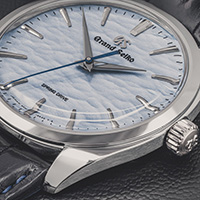NOMOS Glashütte
The minimalist everyday.
Despite all its technical achievements, mastery of design, and unequivocal individuality (all in a short timeframe, might I add), NOMOS remains seriously underrated in my mind. In many cases, you'd have to double your budget to be presented with watches with as much finesse. The majority of what NOMOS offers is exciting, but once you begin to break down the individual components that contribute to the whole brand, then their offerings start to become even more intoxicating. In a crowded market, NOMOS doubles down on its recognisable minimalist design precedent and impressive in-house approach to watchmaking to produce timepieces that genuinely feel distinctive and characterful, traits achieved under its own steam.

As the second half of its name suggests, NOMOS resides in Glashütte, Saxony, Germany, and has done so since its inauguration in the 1990s. If you're a German watchmaker looking to make it big, Glashütte is the epicentre, with the likes of A. Lange & Söhne, and Glashütte Original, as your neighbours. Perhaps just as refreshing as its Bauhaus honouring designs is its founder, who didn't originate from the watch world and bring decades of wealth and industry contacts, but rather a photographer called Roland Schwertner. After the fall of the Berlin Wall, Schwertner established a watch manufacturer to fuse craftsmanship and modern technology that he and his friends could enjoy. These humble yet dignified founding traits proved very successful, with his first creation, the Tangente, being released in 1992. This watch went on to win plenty of design awards and remain a centrepiece of the present-day NOMOS lineup, with widespread influence. The key to the Tangente's success, though, is something I've just hinted at: its design and we have the immensely talented German designer Susanne Günther to thank for it. Günther pulled together the first Tangente design from the influential art and design movement known as Bauhaus and some of the earliest Bauhaus-designed watches of the 1930s. Bauhaus is often described as being simple, but its technicalities lie in its ability to harness functional shapes sparingly applied, uncomplicated structures, holistic approaches, and fundamental industrial theories. The result is straightforward design with entirely applicable traits, qualities that just so happen to align wonderfully with watch design. This method brought forward by Günther is undeniably the defining characteristic of a NOMOS Glashütte watch, allowing the brand to offer traditionally executed watches with a contemporary, fresh, and individual appearance.

Vertical manufacturing was also a key factor Schwertner wanted to achieve with NOMOS, and in 2014 their innovative swing system debuted, demonstrating there was meaning behind his words. This entirely in-house escapement acted as the final piece of the proprietary puzzle that started in 2005, with the introduction of the Alpha movement in the Tangomat - the first NOMOS in-house calibre. Complete with Glashütte style three-quarter plates, Glashütte stripes, heat-blued screws, "NOMOS" perlage, and the "Glashütte" sunburst around its crown wheel, NOMOS demonstrated that regardless of its entry price point, true in house manufacturer was possible.
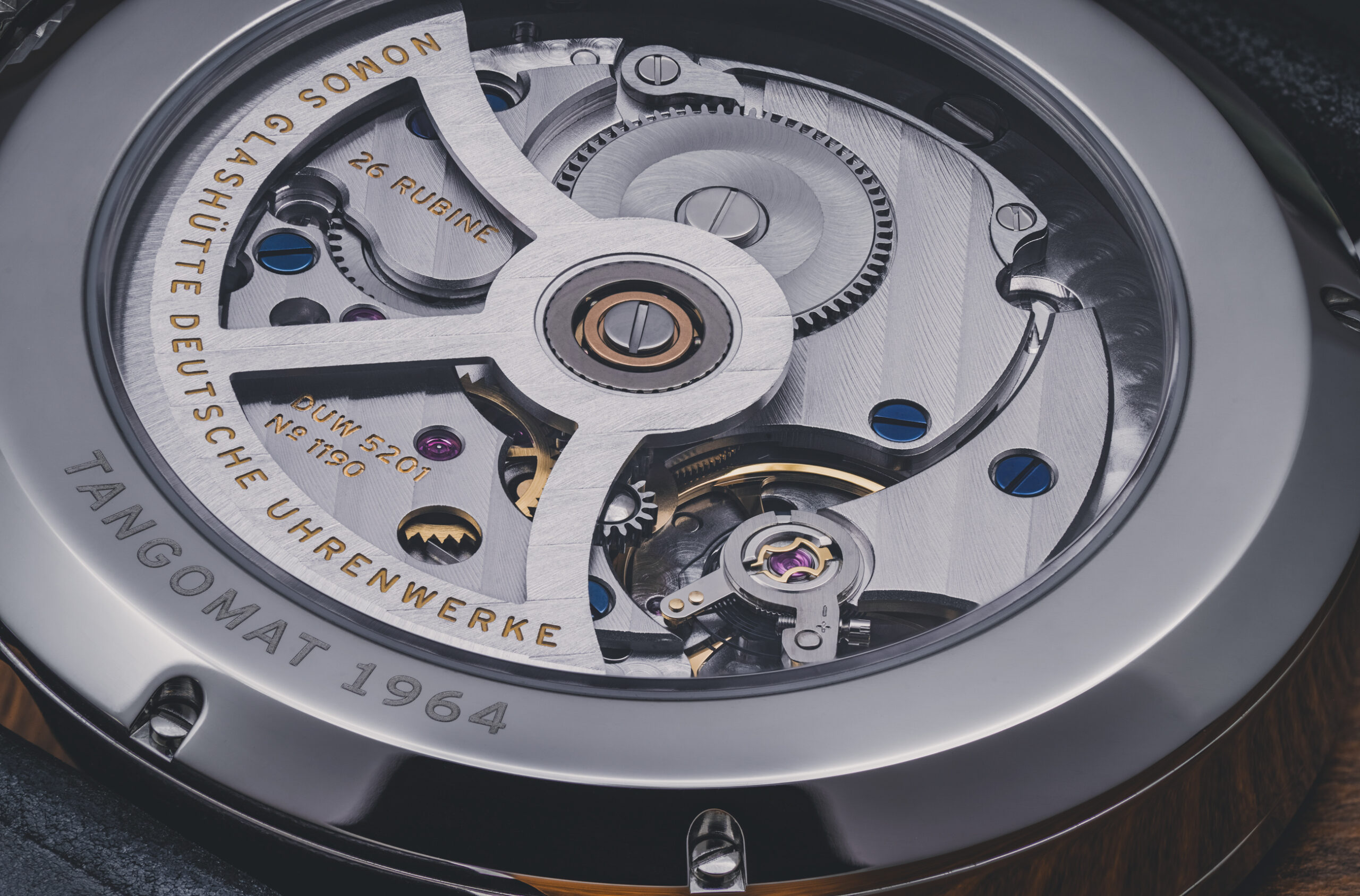
Today, 95% of a NOMOS watch is produced under a NOMOS roof, a rare stat that almost every watch brand that claims in-house watchmaking cannot compete with. This statistic is even more impressive because NOMOS remains an independently owned manufacturer, signifying that in-house claim isn't held up by big group ownership - in short, NOMOS is the real deal.

Let's take a quick moment to see what you can expect when you walk through the doors of James Porter & Son and ask to look at all things NOMOS.
The NOMOS Tangente
Starting at the beginning, we have the Tangente. Without this watch, NOMOS would look very different today, as its core appearance and purpose embody their principles greatly. Today the Tangente remains virtually unchanged since its 1990s birth, carrying the same dial configuration, svelte yet present lug design, and overall versatility that maintains high desirability. This prizewinning classic can be configured with both a manual wind movement or automatic movement (both NOMOS calibres, of course) and today is available with all manner of dial designs, colour schemes and sizes.
Scaled up to 42mm, with a more robust case construction to ensure 300m of water resistance, plastered with luminesce throughout its dial, a purposeful crown guard, and a metal bracelet, the Sport variation of the Tangente is precisely what you'd expect from NOMOS' attempt at a sports watch. A piece just as capable as more conventional divers yet with an appearance still respectful of core NOMOS, the Sport adds more diversity to the Tangente series without compromise.
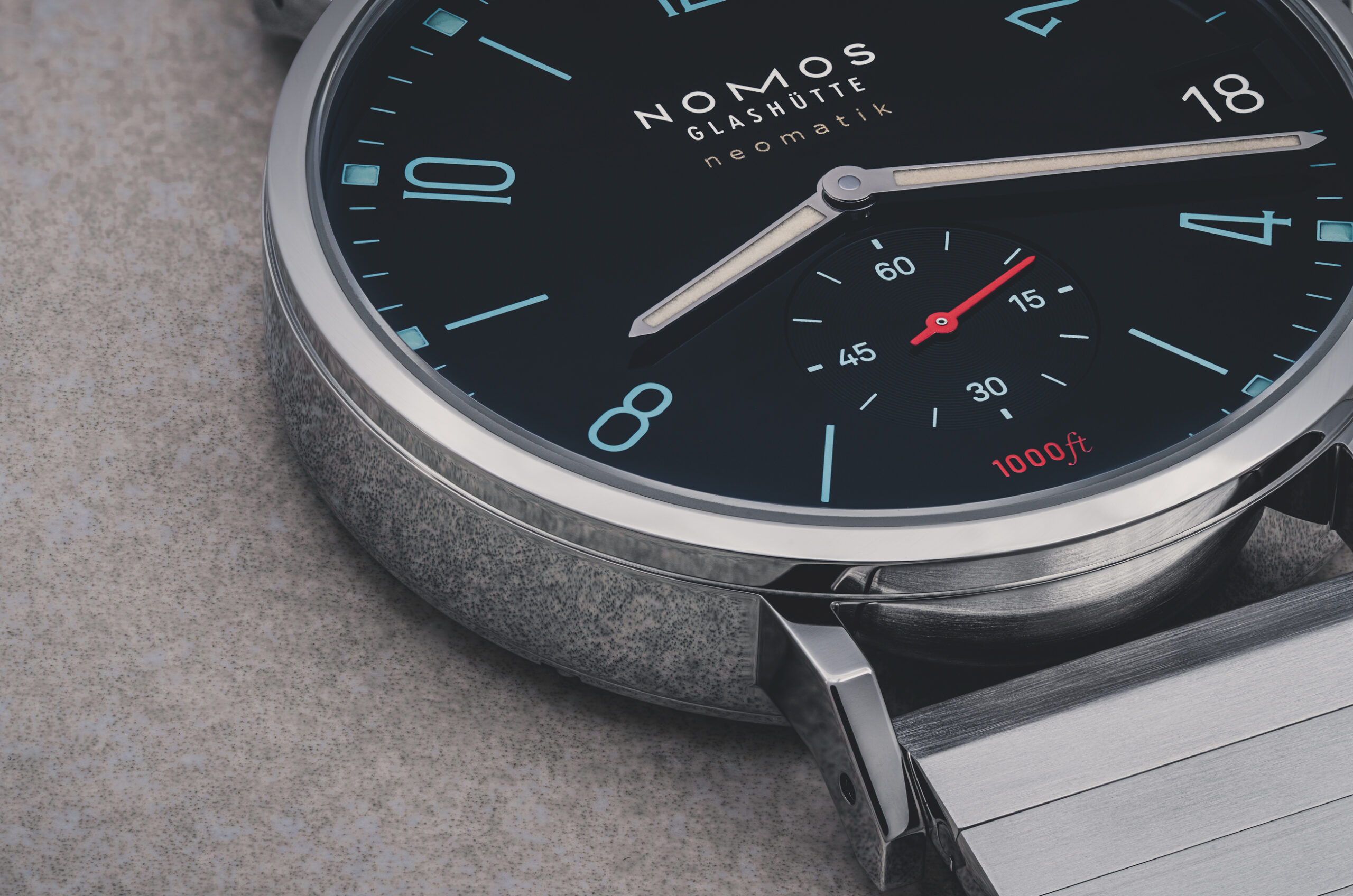
Priced between approximately £1,120 and just shy of £4,000 from 33mm to 42mm, there is undoubtedly a Tangente for everyone. After three decades of production, the Tangente is still the ultimate expression of the German watchmaker and remains a go-to suggestion for first-time NOMOS owners.
The NOMOS Club
If the Tangente is the touch more serious model which pushes the holistic NOMOS narrative, the Club is the one to have a little more fun with its appearance, as its youthful spirit and playful nature is undeniable. The Club series is the one to look at if you're after a watch that doesn't take itself too seriously on the appearance front, as its thicker lug design smoothly fuses into the case body creating an angular exterior. The dial of the Club is where it's really at, though, with lots of different tones, expressive blends of colour, and executions. But don't think the Club is all play and no work; it's all business on the mechanical watchmaking front. In-house NOMOS calibres, both automatic and manual wind, have made their way to the Club to ensure that once you look past the fun designs, the core of the Club is a heavyweight watch series.
Much like the Tangente, Sport variants of the Club offer more robust cases, metal bracelets, increased lume, and elevated water resistance ratings. Alternatively, NOMOS has positioned the Club as the ultimate first mechanical watch for someone. The Campus series presents a less daunting way to enter the often overwhelming world of luxury watches for graduates. With colour palettes akin to the fashion and design world, the Campus provides a soft entry into horology, propped up by serious attention to detail and plenty of watchmaking prowess.
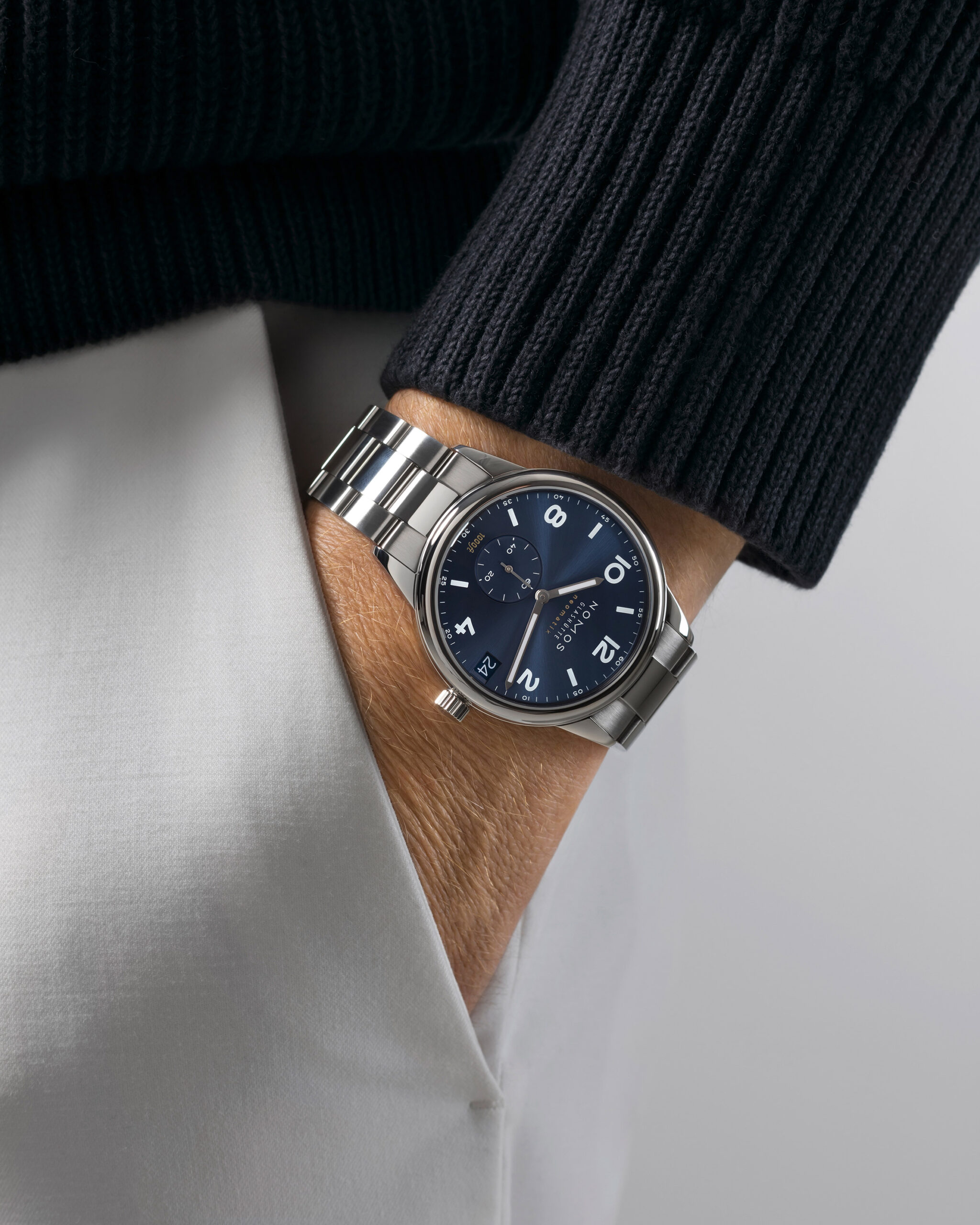
Starting from around £1,000 up to £3,000, the Club is a distinctive and youthful first taste of NOMOS that denotes a great first step into the luxury watch world.
The NOMOS Ahoi
Now we're familiar with the two core NOMOS models, exploring the rest of the NOMOS lineup becomes a little easier, as each remaining series commonly borrows key elements from the aforementioned pieces. Take the Ahoi, for example. Its appearance, calculated build quality, dial structure, and bold sizing are akin to the Tangente Sport. However, what you'll find with the Ahoi is a little more expressive and daring colour decisions.
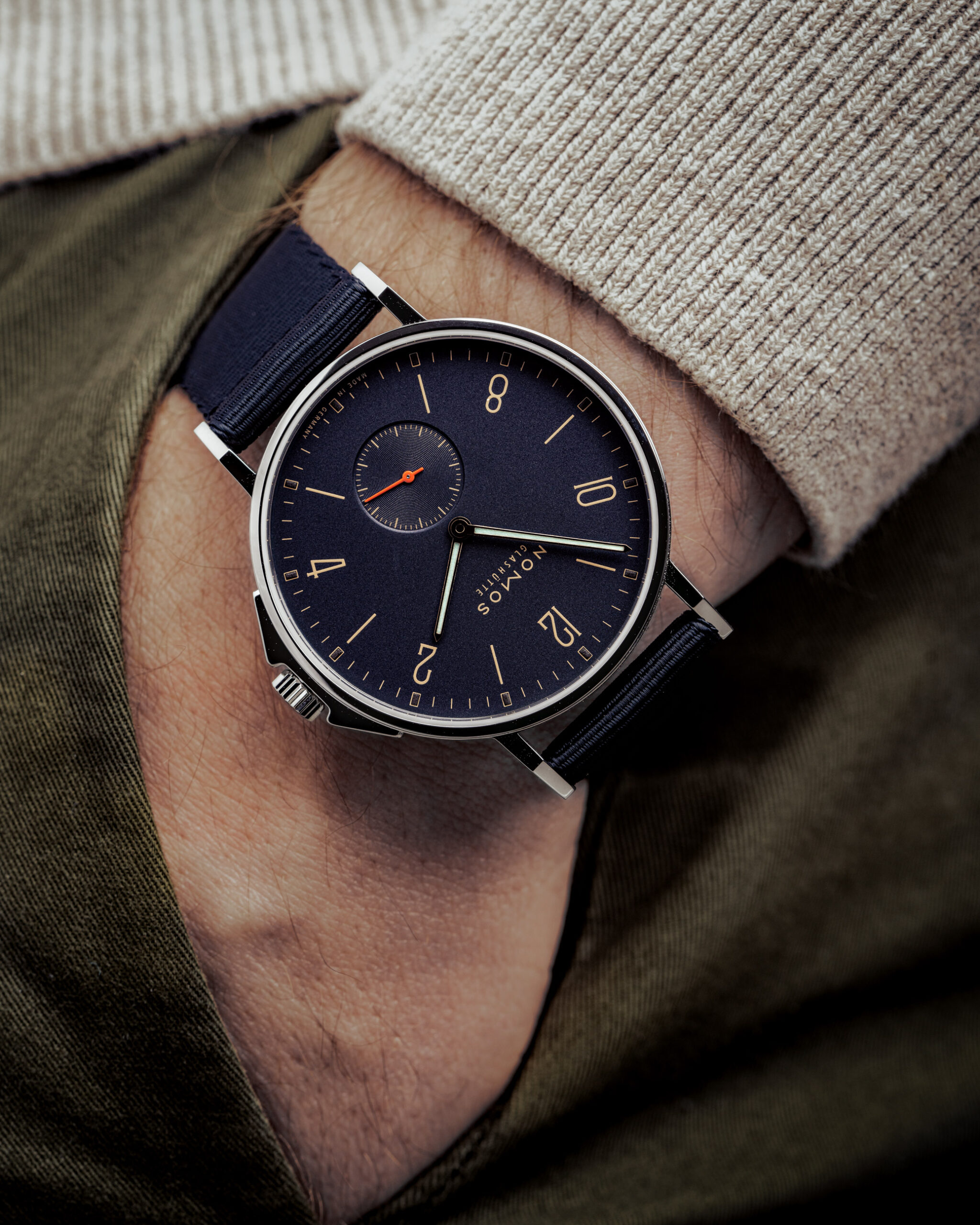
Expect a slightly elevated starting price here of just under £3,000, but remember, this is the sporty, more practical range from NOMOS, so don't think the German watchmakers haven't worked for your hard-earned money; that extra cost is tangible on the wrist.
The NOMOS Tetra
Representing quite a shapely divergence from what we've explored up until now, the Tetra is a slightly more niche model by NOMOS, but it's not without its charm. Perfectly square with a gorgeous double-stepped lug design that feels more Art Deco than Bauhaus, the Tetra challenges the status quo on non-round, typically square watches. A certain French Maison and a polo-playing focused watch manufacturer offer two pieces that have divided and conquered the non-square watch portion of the watch industry, but with their overly classic and traditional focused executions, these watches are somewhat restricted by history. On the other hand, the NOMOS Tetra is modern, fluid, and, thanks to seriously fun dial configurations, incredibly expressive.
Look closely at the dial, and despite the sea of colour on offer, you'll also spot the Tangente-esque dial arrangement, only now in the form of a postage stamp style arrangement. The Tetra is easily one of the most underrated NOMOS models and non-round watches. Starting at £1,260 for a square watch with either a manual or automatic heart that is free from inspiration with one hell of a wrist presence, the Tetra needs to be on your watchlist if there's a square-spaced hole in your watch box.
The NOMOS Minimatik
Proposing a slightly more curvy take on the NOMOS language, the Minimatik echos the playful nature of the Club with a dynamic visual appearance. Appropriately familiar yet with distinction, the Minimatik is a fresh timekeeper by NOMOS, with the case of this series standing out from the rest of the range. With its skinny bezel, soft case curve, and low profile, the Minimatik is one of only a few NOMOS pieces with standout personality from their other models. In addition, the case of the Minimatik is noteworthy, as its elite wearability is made possible thanks to the harmonious shape created by the lugs, sapphire crystal, and case body.
With a plethora of design awards under its belt, the Minimatik is very much the thinking collector's choice of NOMOS with familiarity yet distinction, starting right around the £3,000 mark.
The NOMOS Ludwig
Take a Tangente, dress it up with a clean-cut fresh tuxedo, and the outcome is the Ludwig. Commonly with a railroad track and always with Roman numerals, the Ludwig is a more traditional expression from NOMOS for those seeking a conventional wrist partner. The majority of the Ludwig series is presented with a manual wind movement to elevate the connection between the wearer and the watch, but if you favour the convenience and modernity of an automatic, then Neomatik examples are available, also featuring additional pops of colour and in some cases, a date aperture.
With examples starting from £1,000 right the way up to 18 ct gold pieces for around £8,000, there truly is a Ludwig for every traditional taste. This series is a beautiful representation of one of the many strengths of NOMOS and its universal nature.
The NOMOS Orion
If you like what you see so far with NOMOS but want a watch that is even less cluttered, somehow, NOMOS has made this possible with the most visually stripped-back series in their lineup, the Orion. Taking minimalism to the next level, the Orion sticks to the bare minimum providing an uncompromising presentation of German engineering. Hour markers, a sleek seconds track, extremely slender pencil hands, a subsidiary seconds register, and occasionally a date aperture depending on the reference - the Orion has everything you need and nothing you don't.
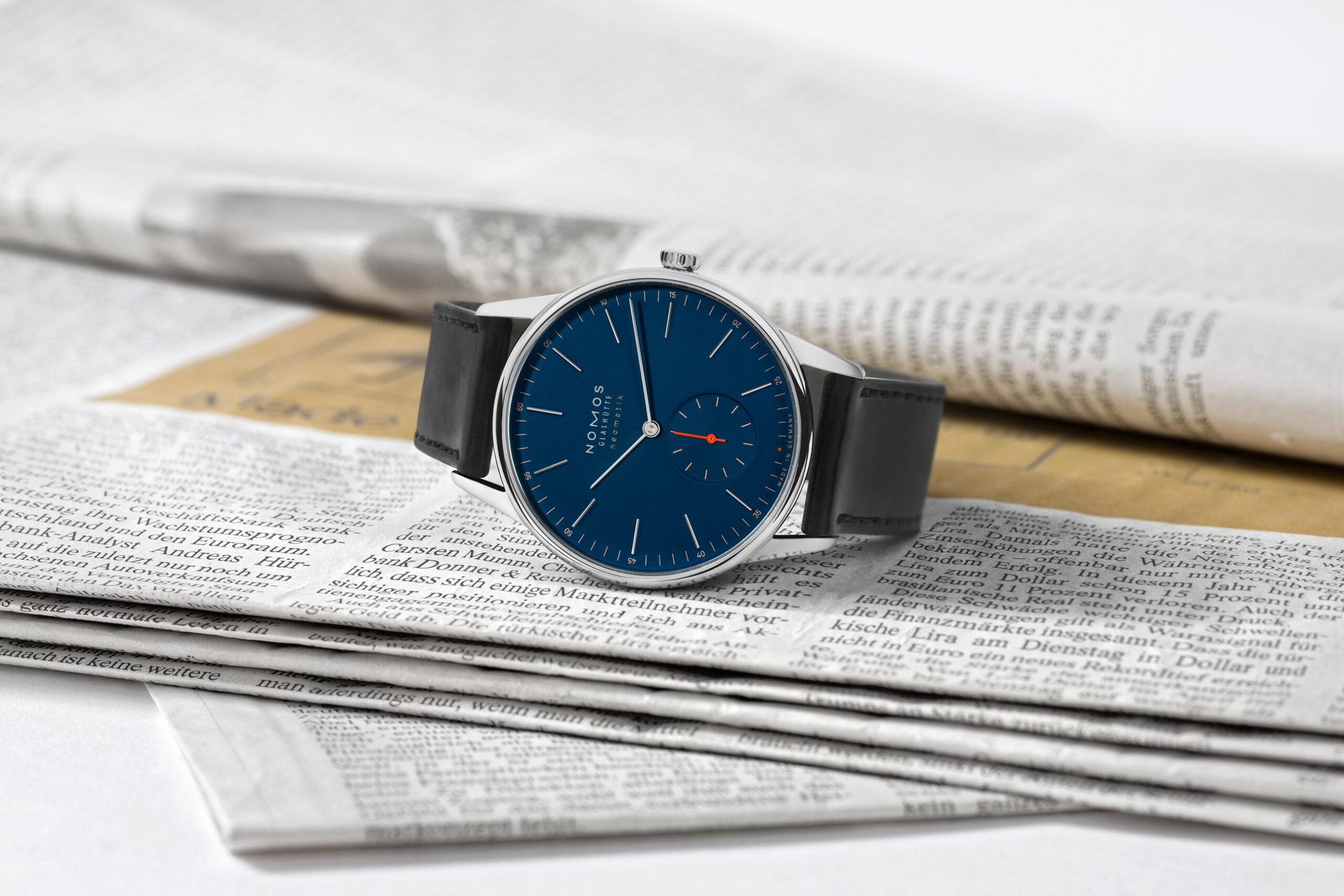
Sure, sometimes specific references introduce some dial texture or a different colour, but the Orion is the most honest realisation of a watch imaginable. Pricing is right around the NOMOS sweet spot of £1,000 - £3,000, and for your money, you can bag yourself a modern watch that is stark in its simplicity but finished to an impeccable standard.
If an understated flex is your style, the Orion is the humble NOMOS for you.
The NOMOS Metro
Perhaps representing the most significant physical variation in case architecture, the Metro possesses the highest level of traditional watchmaking elements in its form, with a wire-esque lug design typically seen on vintage watches from the early 20th century. In fact, the exterior of this piece is even more fascinating as it's essentially just the case body and the lugs, allowing all the attention to head towards to the dial of this individual NOMOS. Furthermore, the hands seen on Metro models also evoke classic timepieces with their syringe-like style.
Sure, there is no denying this is a contemporary creation, but I'd be lying if I said I couldn't help but feel the Metro has some exciting nods to traditional watch design. Complicated examples of the Metro include a peripheral date complication, a novel power reserve indicator and even models in 18 ct gold.
The Metro is a fascinating NOMOS offering with natural individual flair, starting from a hair under £2,000 up to £8,400.
Discover the NOMOS Glashütte collection here.
 Basket
Basket


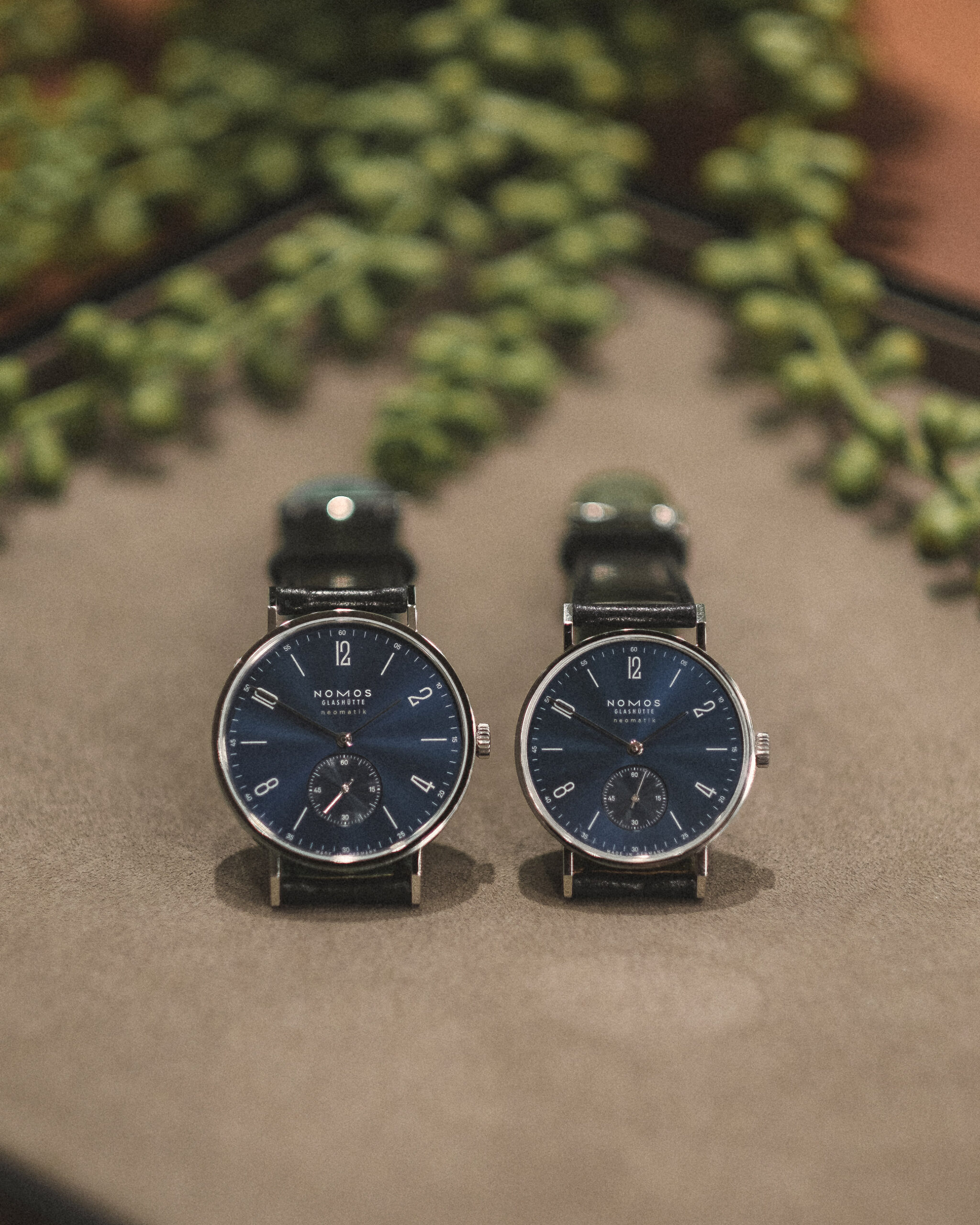
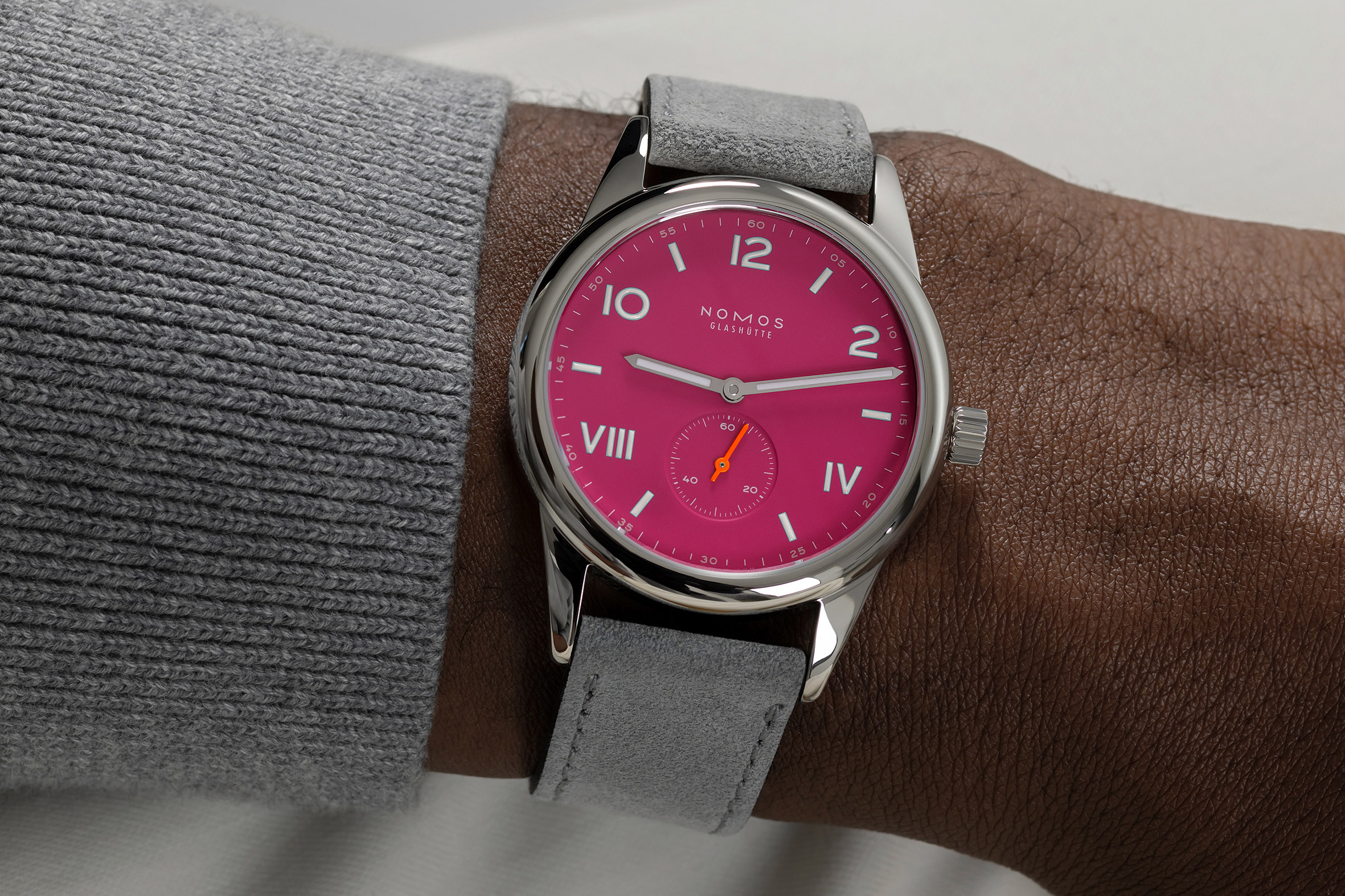

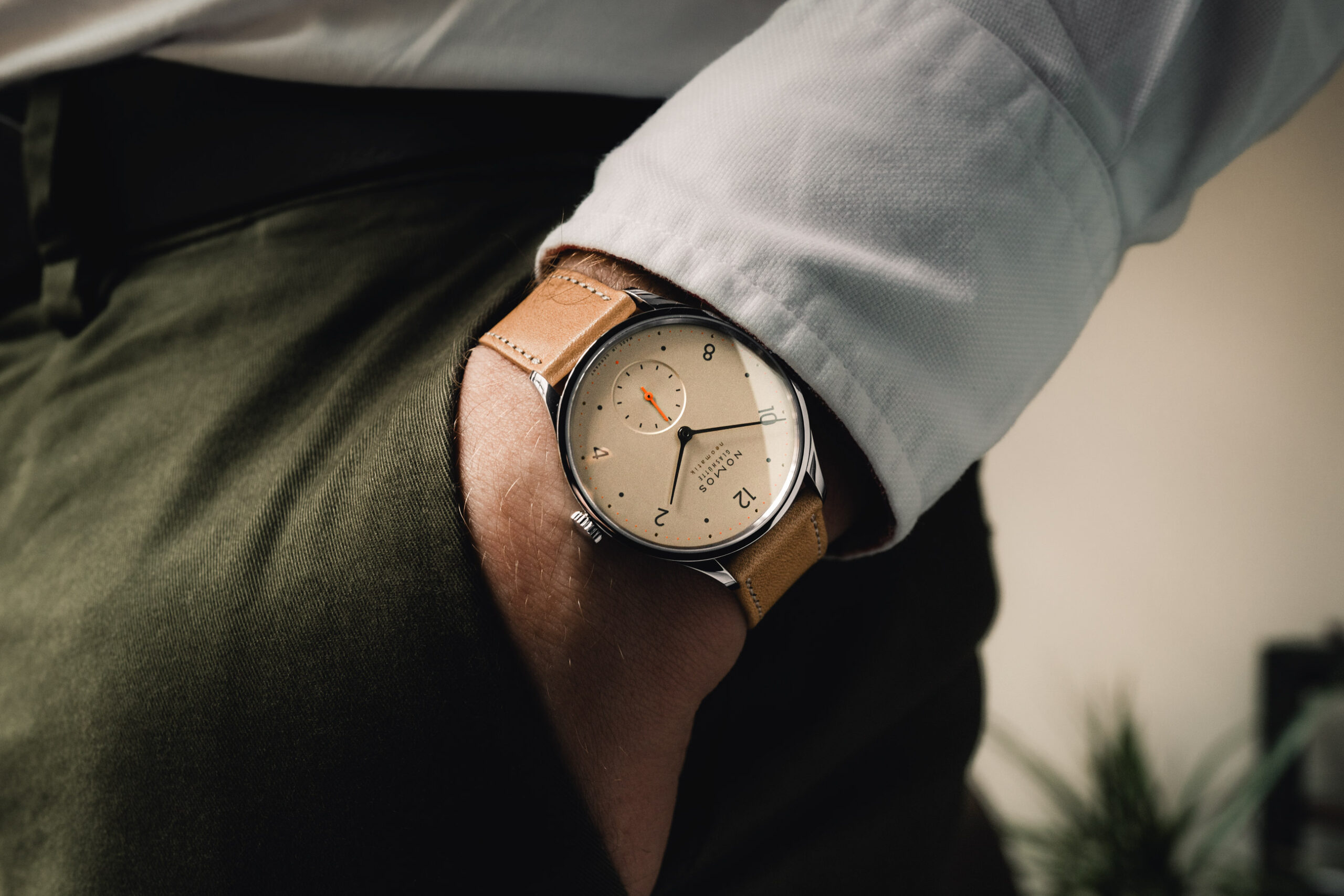
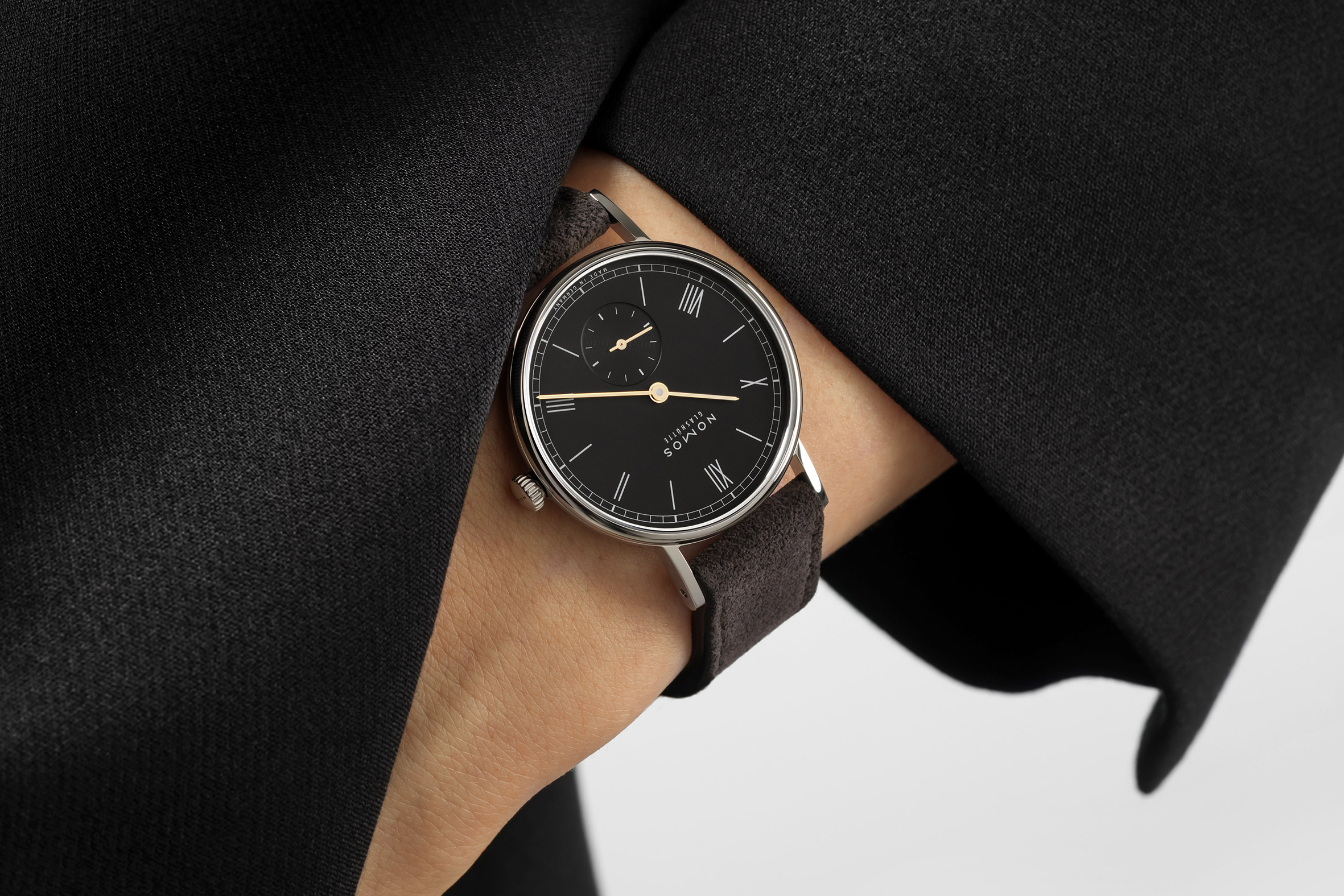



 Back to top
Back to top 0141 221 5855
0141 221 5855 Send us an email
Send us an email






 Secure payment methods
Secure payment methods






